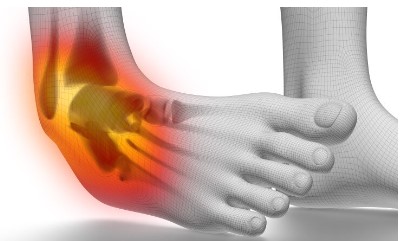Where to Get the Best Lateral Ankle Ligament Pain Treatment?
Where to Get the Best Lateral Ankle Ligament Pain Treatment?

Lateral ankle ligament injuries can be a significant hindrance, impacting your daily activities and overall well-being. Choosing a clinic with expertise, comprehensive care, and a patient-centered approach is essential if you’re seeking the best treatment for lateral ankle ligament pain. At the Foot and Ankle Center of Arizona, we specialize in treating these injuries, ensuring you receive the highest quality care. This blog post will cover all aspects of lateral ankle ligament pain treatment, guiding you toward the best options available.
Understanding Lateral Ankle Ligament Injuries
Lateral ankle ligament injuries occur when the ligaments on the outer side of the ankle are stretched or torn. This typically happens due to a sudden twist or turn of the foot, often seen in sports or accidents. The three main ligaments involved are the anterior talofibular ligament (ATFL), the calcaneofibular ligament (CFL), and the posterior talofibular ligament (PTFL). Understanding the structure and function of these ligaments is crucial for effective treatment.
Common Symptoms of Lateral Ankle Ligament Injuries
Identifying the symptoms of a lateral ankle ligament injury is the first step in seeking appropriate treatment. Common symptoms include:
- Intense pain on the outer side of the ankle
- Swelling and bruising
- Difficulty walking or bearing weight
- Ankle instability and weakness
- A popping sound at the time of injury
The Importance of Early Diagnosis
Early diagnosis of lateral ankle ligament injuries is essential to prevent further damage and ensure a swift recovery. Delaying treatment can lead to chronic instability, recurrent sprains, and long-term complications. At the Foot and Ankle Center of Arizona, we prioritize early diagnosis through a comprehensive examination and state-of-the-art imaging techniques.
Diagnostic Techniques for Lateral Ankle Ligament Injuries
Accurate diagnosis is key to effective treatment. At our clinic, we utilize various diagnostic techniques to assess the extent of ligament damage:
- Physical Examination: Evaluating swelling, tenderness, and range of motion.
- X-rays: Checking for fractures or bone injuries.
- MRI and Ultrasound: Providing detailed images of soft tissue and ligament injuries.
- Functional Tests: Assessing the stability and strength of the ankle.
Conservative Treatment Options
For many lateral ankle ligament injuries, conservative treatments are highly effective. These may include:
- R.I.C.E. Method: Rest, Ice, Compression, and Elevation to reduce pain and swelling.
- Bracing and Supports: Providing stability and preventing further injury.
- Physical Therapy: Strengthening exercises, balance training, and functional rehabilitation.
- Medications: Pain relievers and anti-inflammatory drugs to manage symptoms.
Advanced Non-Surgical Treatments
When conservative treatments are insufficient, advanced non-surgical treatments can offer significant relief. These include:
- Platelet-rich plasma (PRP) Therapy: Using concentrated platelets from the patient’s blood to promote healing.
- Prolotherapy: Injecting a solution to stimulate the body’s natural healing response.
Surgical Interventions for Severe Injuries
In cases of severe ligament damage or chronic instability, surgical intervention may be necessary. Dr. Kris A. DiNucci, a renowned podiatric foot and ankle surgeon at the Foot and Ankle Center of Arizona, specializes in these procedures. Surgical options may include:
- Ligament Repair: Stitching the torn ligaments back together.
- Ligament Reconstruction: Using grafts to rebuild the damaged ligaments.
- Arthroscopy: Minimally invasive surgery to clean out any debris or repair minor ligament damage.
Post-Surgery Rehabilitation
Recovery from surgery requires a carefully structured rehabilitation program. Our team at the Foot and Ankle Center of Arizona will guide you through each stage, focusing on:
- Pain Management: Ensuring comfort and reducing pain.
- Physical Therapy: Regaining strength, flexibility, and balance.
- Functional Training: Preparing you to return to daily activities and sports.
Preventing Future Lateral Ankle Ligament Injuries
Preventing future injuries is an integral part of treatment. Here are some strategies:
- Strengthening Exercises: Regular exercises to strengthen the ankle and improve stability.
- Proper Footwear: Wear shoes that provide good support and fit well.
- Ankle Braces: Using braces during high-risk activities to provide additional support.
- Balance Training: Improving proprioception and balance to reduce the risk of re-injury.
Choosing the Foot and Ankle Center of Arizona
Selecting the right clinic for your lateral ankle ligament pain treatment is crucial for your recovery. The Foot and Ankle Center of Arizona offers:
- Expertise: Led by Dr. Kris A. DiNucci, a highly experienced podiatric foot and ankle surgeon.
- Comprehensive Care: From diagnosis to rehabilitation, we provide a full range of services.
- Patient-Centered Approach: Personalized care tailored to your specific needs.
- State-of-the-Art Facilities: Equipped with the latest technology for accurate diagnosis and effective treatment.
Conclusion
Lateral ankle ligament injuries require timely and effective treatment to ensure a full recovery and prevent future complications. At the Foot and Ankle Center of Arizona, we are dedicated to providing the best care for your lateral ankle ligament pain. With our expertise, comprehensive approach, and patient-focused care, you can trust us to help you regain your mobility and quality of life. If you are experiencing symptoms of a lateral ankle ligament injury, don’t hesitate to contact us and schedule an appointment. Your path to recovery starts here.
